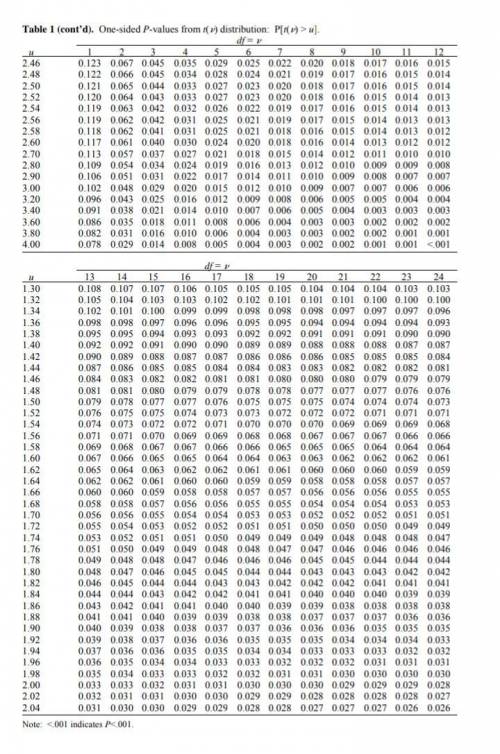
Mathematics, 28.07.2020 16:01 sahaitong2552
The true average diameter of ball bearings of a certain type is supposed to be 0.5 in. A one-sample t test will be carried out to see whether this is the case. What conclusion is appropriate in each of the following situations?
(a) n = 15, t = 1.66, a = 0.05
a. Reject the null hypothesis. There is sufficient evidence that the true diameter differs from 0.5 in
b. Reject the null hypothesis. There is not sufficient evidence that the true diameter differs from 0.5 in
c. Do not reject the null hypothesis. There is sufficient evidence that the true diameter differs from 0.5 in
d. Do not reject the null hypothesis. There is not sufficient evidence that the true diameter differs from 0.5 in
(b) n = 15, t = 1.66, a = 0.05
a. Reject the null hypothesis. There is sufficient evidence that the true diameter differs from 0.5 in
b. Reject the null hypothesis. There is not sufficient evidence that the true diameter differs from 0.5 in
c. Do not reject the null hypothesis. There is sufficient evidence that the true diameter differs from 0.5 in
d. Do not reject the null hypothesis. There is not sufficient evidence that the true diameter differs from 0.5 in
(c) n = 26, t = 2.55, a = 0.01
a. Reject the null hypothesis. There is sufficient evidence that the true diameter differs from 0.5 in
b. Reject the null hypothesis. There is not sufficient evidence that the true diameter differs from 0.5 in
c. Do not reject the null hypothesis. There is sufficient evidence that the true diameter differs from 0.5 in
d. Do not reject the null hypothesis. There is not sufficient evidence that the true diameter differs from 0.5 in
(d) n = 26, t = 3.95
a. Reject the null hypothesis. There is sufficient evidence that the true diameter differs from 0.5 in
b. Reject the null hypothesis. There is not sufficient evidence that the true diameter differs from 0.5 in
c. Do not reject the null hypothesis. There is not sufficient evidence that the true diameter differs from 0.5 in
d. Do not reject the null hypothesis. There is sufficient evidence that the true diameter differs from 0.5 in
You may need to use the appropriate table in the Appendix of Tables to answer this question.

Answers: 1
Another question on Mathematics

Mathematics, 21.06.2019 14:00
Ateacher asked his students to vote for an animal to be their class pet. five-eighteenths of the students voted for a rabbit, voted for a snake, and voted for a hamster. which statement is true? more students voted for a hamster than a snake. more students voted for a snake than a rabbit. more students voted for a rabbit than a hamster. more students voted for a snake than a hamster.
Answers: 3

Mathematics, 21.06.2019 15:30
Given the box plot, will the mean or the median provide a better description of the center? box plot with min at 10.5, q1 at 11.5, median at 12.5, q3 at 13.5, max at 15
Answers: 2

Mathematics, 21.06.2019 20:30
Peter applied to an accounting firm and a consulting firm. he knows that 30% of similarly qualified applicants receive job offers from the accounting firm, while only 20% of similarly qualified applicants receive job offers from the consulting firm. assume that receiving an offer from one firm is independent of receiving an offer from the other. what is the probability that both firms offer peter a job?
Answers: 1

Mathematics, 21.06.2019 22:30
Maria found the least common multiple of 6 and 15. her work is shown below. multiples of 6: 6, 12, 18, 24, 30, 36, 42, 48, 54, 60, . . multiples of 15: 15, 30, 45, 60, . . the least common multiple is 60. what is maria's error?
Answers: 1
You know the right answer?
The true average diameter of ball bearings of a certain type is supposed to be 0.5 in. A one-sample...
Questions

Mathematics, 30.04.2021 01:10

Mathematics, 30.04.2021 01:10

Mathematics, 30.04.2021 01:10


Chemistry, 30.04.2021 01:10




Mathematics, 30.04.2021 01:20

Mathematics, 30.04.2021 01:20


Mathematics, 30.04.2021 01:20


Mathematics, 30.04.2021 01:20

Mathematics, 30.04.2021 01:20


History, 30.04.2021 01:20

Mathematics, 30.04.2021 01:20






